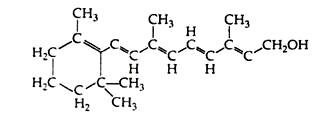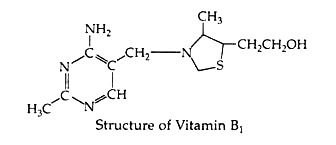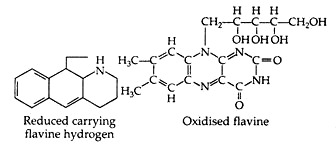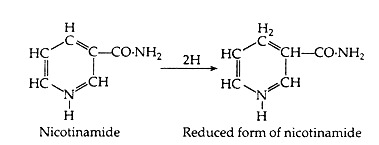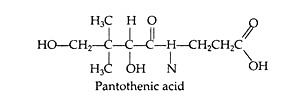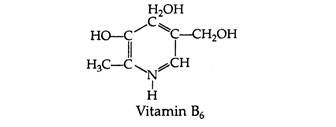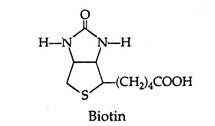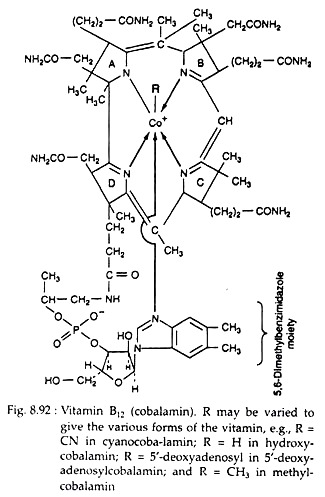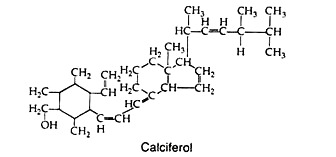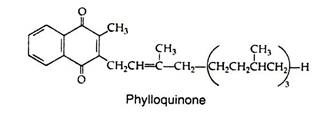List of eight main types of vitamins required by human body:- 1. Vitamin A 2. 2. Vitamin B Complex 3. Vitamin H 4. Vitamin M 5. Vitamin B12 6. Vitamin C 7. Vitamin D 8. Vitamin K 9. Vitamin E.
1. Vitamin A (Retinol):
Clinical name:
It is clinically called axerophthol or antixerophthalmic vitamin or antinyctalopic vitamin.
ADVERTISEMENTS:
Sources:
Plant:
Yellow ripe fruits, vegetables like: carrot, tomato, mango, and sweet potato etc., green leafy vegetables e.g. cabbage, lettuce etc. Plants do not contain as such, rather they store pro-vitamin of retinol called carotene.
Animal:
ADVERTISEMENTS:
Fish liver oils (e.g. cod liver oil, shark liver oil, halibut liver oil etc.), fatty meat, milk, butter, ghee, egg yolk, and kidney.
Structure:
Vitamin A exists chemically in two forms retinol, or vitamin A, and retinol2 or vitamin A2. Retinol1 is reduced form and retinol2 is oxidised form, it is also called as dehydroretinol. It is an unsaturated monohydric alcohol. Figure of transform of vitamin A] (found in mammals and most vertebrates) is given below
ADVERTISEMENTS:
Functions:
1. It is essential for synthesis of visual pigments of rods and cones (rhodopsin and iodopsin).
2. Plays a vital part in the structural integrity and functioning of epithelial cells, particularly the mucus membranes of cornea, conjunctiva, lacrimal gland, salivary gland, pharynx, respiratory tract, tongue etc.
3. Helps in normal growth, reproduction and metabolism.
4. Keeps the skin smooth, healthy and moist and Kelps In the functioning of sweat and sebaceous glands, and hair follicle.
Deficiency symptoms:
1. A deficiency in the very early post-natal development leads to permanent blindness, and later in life produces poor vision in dim light, more precisely night blindness or nyctalopia.
2. Malformed and keratinised epithelia in the cornea of eye cause a disease called xerophthalmia.
ADVERTISEMENTS:
3. Ill-formed epithelia in skin and lining the tracts of intestine and lung lead to susceptibility to infection by pathogens.
4. Fail to develop proteins for the growth in young animals.
2. Vitamin B Complex:
This group comprises in heterogeneous collection of chemicals. There are at least twelve substances, classed as B vitamins. Although the members of the vitamin B complex differ chemically, they are placed in the same group because they all act as coenzymes and their actions are closely related. Man requires at least ten of them to maintain normal function of the body. Some members of this group were named numerically as B1, B2, B6, B12 etc., but some others were not.
(i) Vitamin B1 (Thiamine):
Clinical name:
It is clinically called as aneurin or anti-beriberi vitamin, because it prevents neuritis and beriberi.
Sources:
Plant:
Seeds of pea, beans and soybean, nuts and cereals like rice, wheat are good source of thiamine. Yeast is very good source and it is also found in carrot, beet, onion, cauliflower, turnip, orange etc.
Animal:
Meat, liver and egg-yolk are good sources but milk is a poor source.
Structure:
Thiamine consists of a pyrimidine linked to sulphur containing thiazole unit.
Functions:
1. It acts as a vital coenzyme in the oxidative decarboxylation reaction, catalysed by the enzymes pyruvic dehydrogenase and α-ketoglutaric dehydrogenase of TCA cycle. It also acts as coenzyme in transketolase reaction of pentose phosphate pathway. Thus it is involved in carbohydrate metabolism and energy production.
2. It helps in fat metabolism, where long chain fatty acids are broken down and de-carboxylated slowly.
3. It helps in nerve impulse transmission by forming some constituent of nerve membrane and neurotransmitter acetylcholine.
Deficiency symptoms:
1. Deficiency leads to a disease called beriberi, which is characterised by neuritis (inflammation of peripheral nerve cells). Beriberi may be of two types – wet beriberi and dry beriberi. The wet beriberi is characterised by oedema and cardiac problems. In dry beriberi the patient is emaciated.
2. Pyruvic acid and other toxic metabolites accumulate and upset membrane functioning resulting in paralysis.
(ii) Vitamin B2 (Riboflavin):
Clinical name:
It has no clinical name because its deficiency does not produce any typical disease.
Sources:
Plant:
It is found in most of the natural foodstuffs. Yeast, germinated seeds (pea, gram, beans etc.) and leafy vegetables are good plant sources.
Animal:
Important animal sources include liver, meat, fish, egg and milk.
Structure:
It is a ribose sugar containing flavine compound.
It is a yellow chemical with following structural formula:
Functions:
1. In cells it acts as a co-enzyme called flavoproteins. It has two forms – flavine adenine dinucleotide (FAD) and flavine mono-nucleotide (FMN).
2. Flavoproteins are H2 acceptors or oxidoreductases that take part in cellular respiration. Some of the examples are – SDH (of TCA cycle), acyl CoA dehydrogenase (of β-oxidation), and amino acid oxidase (that catalyses oxidative deamination of amino acids).
3. It helps in general growth of the body and proper maintenance of health and functioning of ectodermal tissues like skin and oral mucosa.
Deficiency symptoms:
1. Causes lesions of the skin and shedding of hair in mammals – called Seborrheic dermatitis.
2. Causes invasion of the cornea by blood capillaries, with itching eyes and photophobia.
3. Causes magenta coloured inflammation of the tongue – called Glossitis.
4. Causes swelling and reddening of lips with angular fissures – called Cheilosis.
(iii) Vitamin B3 (Nicotinic acid/nicotinamide/Niacin):
Clinical name:
P-P factor or Pellagra preventing factor.
Source:
Plant:
It is abundant in yeast, legumes, peanuts and outer coat of cereals.
Animal:
Liver, meat, fish etc. Egg and milk are poor sources of this vitamin.
Structure:
1. It acts as coenzyme nicotinamide adenine dinucleotide (NAD) or its phosphate (NADP) and their reduced forms NADH2 and NADPH2, respectively.
2. These coenzymes are required for the action of various enzymes of dehydrogenase and reductase groups that are involved in glycolysis, TCA cycle, pentose phosphate pathway, β-oxidation of fatty acids and many other important metabolic pathways.
Deficiency symptoms:
1. Causes the disease pellagra, which is characterised by diarrhoea, dermatitis and dementia.
2. With beriberi the condition would be fatal in an extreme form.
3. Symptoms indicate general break down in membrane functioning.
(iv) Pantothenic acid:
Clinical name:
Previously it was called ‘filtrates factor’ or ‘chick anti-dermatitis factor’.
Sources:
Plant:
Sweet potato, legumes, nuts, fresh fruits and vegetables are good sources but the amount they possess is less than animal sources.
Animal:
Liver, egg, milk and meat are good sources of this vitamin.
Structure:
Functions:
1. It is a constituent of coenzyme A and required in the formation and metabolism of acetyl CoA and acyl CoA. Therefore, involved in carbohydrate and lipid metabolism, e.g., TCA cycle, synthesis and oxidation of fatty acids, cholesterol synthesis etc.
2. It is vital in the synthesis of acetylcholine (synaptic transmitter).
Deficiency symptom:
1. Gastrointestinal disorder
2. Easy fatigue
3. Disturbance in sleep
4. Mental disorder.
5. Upset in adrenal function takes place in rats.
(v) Vitamin B6 (Pyridoxine):
Clinical name:
Adermin or rat anti-dermatitis factor. It is active in two forms – pyridoxal phosphate and pyridoxamine phosphate
Sources:
Plant:
Yeast and outer coating of cereals, like wheat, rice, maize etc.
Animal:
Meat, liver and egg yolk.
Structure:
Functions:
1. Acts as a vital coenzyme in transamination of amino acids necessary in protein metabolism, e.g.,
2. It probably helps in the absorption of amino acid from the intestine.
3. It participates in muscle glycolysis.
4. It takes part in the synthesis of sphingomyelin lipids.
Deficiency symptoms:
1. Produces convulsion, dermatitis, gastrointestinal abnormalities, and microcytic anaemia.
2. Produces neuropathy.
3. Vitamin H (Biotin):
Clinical name:
It was named as anti-egg-white injury factor. Intestinal bacteria usually synthesise this vitamin.
Sources:
Plant:
Yeast, legumes, peanuts, molasses, tomato, green vegetables etc. It is also synthesised by intestinal bacteria.
Animal:
Liver, kidney, egg yolk, milk etc.
Structure:
This is a sulphur-containing co-enzyme, which is important in growth. It allows transfer of carboxyl groups from one molecule to another and is involved in numerous biosynthesis within the mammal.
Functions:
It acts as coenzyme for the enzymes catalysing carboxylation reactions (i.e. addition of CO2 or CO2 fixation).
Some common examples are:
Pyruvate carboxylase that catalyses addition of CO2 in pyruvic acid to form oxaloacetic acid.
Acetyl CoA carboxylase that forms malonyl CoA by adding CO2 to acetyl CoA for fatty acid synthesis.
Deficiency symptoms:
Biotin deficiency in man produces dermatitis, anorexia, pain, fatigue and weakness of muscle.
4. Vitamin M (Folic acid, folionic acid, folacin):
Clinical name:
It is pteroyl glutamic acid.
Sources:
Plant:
It is found in yeast and widely distributed in green leaves of vegetables, e.g. spinach, curry leaves, mint, cabbage etc. It is also synthesised by intestinal bacteria.
Animal:
Kidney and liver.
Structure:
Functions:
1. It is a co-enzyme in the transfer of single carbon fraction from one substance to another (e.g. methyl, formyl, formimino, etc.) or metabolism of one carbon compound.
2. It is vital in synthesis of purine, pyrimidine and some amino acids.
3. It promotes the formation of red and white blood cells.
Deficiency symptoms:
1. Symptom of deficiency in man is megaloblastic, or macrocytic or pernicious anaemia (characterised by large, nucleated RBC with little haemoglobin) and leucopenia (fall in number of WBC).
2. Diarrhoea and gastrointestinal lesions may be associated with the above-mentioned anaemia.
5. Vitamin B12 (Cobalamin):
Clinical name:
It is termed as anti-pernicious anaemia factor or Castle’s extrinsic factor. As it is a compound of cobalt, it is called Cobalamin. Several active factors of this vitamin are known e.g. Cyanocobalamin, hydroxyl-cobalamin, nitro-cobalamin, chloro-cobalamin.
Sources:
Plant:
It is not found in foodstuffs of plant origin.
Animal:
It is abundant in animal food e.g. liver, meat, fish, egg yolk, milk, cheese. In man this vitamin is synthesised by intestinal bacteria, but the amount is not sufficient. In herbivores the bacteria of stomach can synthesise sufficient amount.
Structure:
This is a cobalt-containing complex, which is present in very minute amount in the liver (Fig. 8.92).
Functions:
1. It acts as coenzyme in the form of cob-amide, which is involved in DNA synthesis.
2. It also helps in the action of folic acid.
3. Helps in general growth.
Deficiency symptoms:
1. Pernicious or megaloblastic or macrocytic anaemia.
2. Disorders of nervous system including demyelination and degeneration of nerves, loss of sensation or paralysis.
6. Vitamin C (Ascorbic acid):
Clinical name:
It is called antiscorbutic vitamin.
Sources:
Plant:
In more or less all fruits and vegetables. Citrus fruits e.g. lemon, orange, amlaki, pineapple, mango are outstanding sources.
Animal:
Many animals, except the primates (e.g. man, monkey), can synthesise ascorbic acid in their liver and, hence, they do not depend on dietary source. So, this vitamin can be considered as a hormone in these animals.
Structure:
It is water soluble and destroyed on heating. It can be easily reduced and oxidised again.
Functions:
1. It acts as coenzyme for oxidation-reduction and hydroxylation reaction.
2. Helps in metabolism of amino acids, synthesis of collagen and other intercellular cementing materials, iron absorption and formation of adrenocortical hormone.
3. It is necessary for the formation of connective tissue, maintenance of the integrity of tissues like bones, teeth and capillaries and wound healing. It helps in erythropoiesis and anti-stress action.
Deficiency symptoms:
1. Causes scurvy, which is characterised by haemorrhages.
2. Due to lack of cement synthesis, fragility of capillaries and other issues occur causing haemorrhage.
3. Defective formation and loosening of teeth associated with spongy and bleeding gums.
4. Skeletal weakness and fragility of bones occur.
5. Disturbances in normal melanin pigmentation by tyrosine.
7. Vitamin D (Caciferol):
Sources:
1. In the intestine, cholesterol is dehydrogenated to de-hydro-cholesterol and in the skin, this is changed to vitamin D by action of the ultraviolet light from the sun.
2. Meat, liver and milk.
Structure:
Functions:
It allows the absorption of calcium from the gut which can then be used in blood, bone and muscle.
Deficiency symptoms:
If the gut absorption decreases their Ca++ ion is released from bones and muscle, which lead to demineralization of the bones and to muscular paralysis.
Demineralization of bones is called rickets.
8. Vitamin K (Phylloquinone):
Clinical name:
Phylloquinone
Sources:
Green leaves of alfa alfa, spinach, lettuce, cabbage etc. and vegetable oils.
Structure:
Functions:
1. Helps in coagulation of blood.
2. Involved in mitochondrial oxidative phosphorylation.
Deficiency symptoms:
It is important to man by regulating the amount of prothrombin in blood and affects its clotting.
9. Vitamin E (Tochopherol):
Clinical name:
Tochopherol.
Sources:
Almost all vegetables contain some amount of vitamin E. Reliable sources are wheat-germ oil, cottonseed oil, sunflower oil, corn oil etc.
Structure:
Functions:
It is concerned with reproduction. It is called natural antioxidant. It induces chemical stress and lengthens life.
Deficiency symptoms:
Lack of vitamin E may result in diverse effects in different species ranging from ageing, sterility in both male and female rat, to muscular dystrophy in rabbits.
